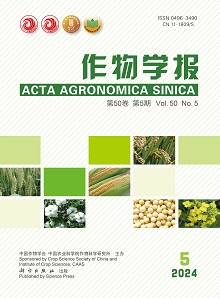-
Development and Chromosome Mapping of 81 New Wheat EST-SSR Markers and Application for Characterizing Rye Chromosomes Added in Wheat
- ZHUANG Li-Fang;SONG Li-Xiao;FENG Yi-Gao;QIAN Bao-Li;XU Hai-Bin;PEI Zi-You;QI Zeng-Jun
-
Acta Agron Sin. 2008, 34(06):
926-933.
doi:10.3724/SP.J.1006.2008.00926
-
 Abstract
(
2346 )
Abstract
(
2346 )
 PDF (712KB)
(
1804
)
PDF (712KB)
(
1804
)
 Save
Save
-
Related Articles |
Metrics
Genomic microsatellites (gSSR) have been widely used in cultivar fingerprinting, genetic diversity assessment, molecular mapping and marker assisted breeding, but development of SSR markers from genomic libraries is expensive and inefficient. With the availability of large numbers of expressed sequence tags (ESTs), development of EST-derived SSR (eSSR) markers is becoming an efficient and low-cost option for many plant species. To date, numerous eSSR markers have been developed and used in comparative and genetic mapping in many plant species, which showed a higher rate of transferability than gSSR markers. In wheat (Triticum aestivum L.), until January, 2007, more than 854 015 ESTs have been deposited in the public GenBank (http://www.ncbi.nlm.nih.gov), and more than 16 000 ESTs have been physically positioned on different bins of wheat chromosomes via Southern blotting analysis on a set of wheat deletions. Despite series of PCR based eSSR primers were designed, only a small number of them have been tested in wheat or its relative genomes. The purposes of our research were: 1) to develop and map of new eSSR markers of wheat; 2) to test the transferability of these markers in wheat relatives; and 3) to screen of new markers tagging different rye (Secale cereale L.) chromosomes. In this paper, 81 new EST-derived SSR markers were developed from salinity stressed and stem relative cDNA libraries of wheat. Of them, 67, 46, 18, and 61 markers produced 124, 72, 26, and 124 stable amplicons in genomes of wheat, rye, Haynaldia villosa L. Schur., and barley (Hordeum vulgare L.), respectively, indi-cating high transferability of these markers in wheat relatives. Twenty-two markers produced polymorphic amplicons between wheat landrace Chinese Spring and Huixianhong, and 23 markers produced polymorphic loci between barley cultivar Sileng Damai and Kuaiying Luomai, indicating potential use of these markers in genetic mapping and fingerprinting. Among the 67 eSSR markers with stable amplicons in wheat, 81 loci amplified by 43 markers were further mapped on 18 different wheat chro-mosomes using a set of wheat nulli-tetrasomics except 4B, 3D, and 6D. The other 24 markers could not be mapped on single chromosome of wheat mainly due to the possible duplications of gene occurred in wheat genomes. Of the 81 mapped loci in wheat, 29, 30, and 22 were assigned on A, B, and D genome, respectively. Of the 7 homoeologous groups of wheat, the mapped loci var-ied from 6-23, chromosomes of group 2 were found with the most loci (23) while group 5 with the least (6). For the single chro-mosome, the mapped loci varied from 1-11, chromosome 2B with the most (11) and 5A with the least (1). By amplified on ge-nomes of Huixianhong, rye cultivar ‘Jingzhou Heimai’and their amphiploid Jinghui 1, 30 out of 46 eSSR markers with stable amplicons in rye screened in the previous transferability test produced specific loci of rye in Huixianhong background. Using 11 Huixianhong-Jingzhou Heimai alien chromosome lines except 6R and 3RL, eight markers were further assigned on different sin-gle chromosomes including 1R (1), 4R (3), 5R (3) and R7 (1), 7 markers were assigned on more than one chromosome indicating possible duplication of gene occurred in rye genome, and 15 markers could not be mapped in the current wheat-rye alien chromo-some lines indicating potential use in other study.

 WeChat
WeChat
 WeChat
WeChat